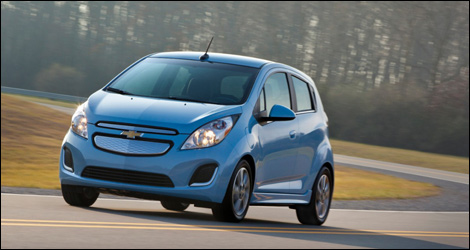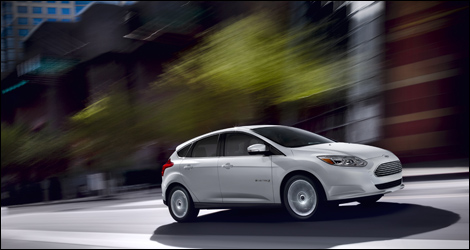May
29th
Stay connected Subscribe to our RSS feed
If it takes five times longer to recoup the additional expense of a ''plug-in'' EV versus the standard EV, then why should we buy one?
Involved environmentalism
It's obvious that by driving an electric vehicle we reduce the emission of greenhouse gasses by 100 %. Choosing a ''plug-in'' EV also helps reduce our negative environmental impact. We are looking at a reduction of CO2 emissions in the neighborhood of 75 % versus a traditional combustion-engined vehicle.
By choosing a hybrid vehicle that consumes 4 to 5L/100km, we are cutting the fuel consumption of the average vehicle by half. A ''plug-in'' EV will reduce the fuel consumption of a hybrid by half. These little steps add up in the end to big reduction in CO2 emissions.
If we were to whip out the old calculator, we could ring-up some very interesting numbers as far as the environmental impact of plug-in EV's is concerned. Let's start with these assumptions: the average vehicle travels 18,000 kms annually, and the plug-in EV will be recharged once a day.
Compact: Consumption: 8,5 L/100 km; CO2 emissions: 3,6 metric tons
Hybrid: Consumption : 4,5 L/100 km, CO2 emissions: 1,9 metric tons
Plug-in Hybrid: Consumption : 0 L/100 km for 25 km, and 4,5 L/100 km thereafter: CO2 emissions:
Complicated ROI calculation for plug-ins
If calculating your ROI is easy for an EV, because there is no fuel being used, trying to figure out the ROI for a plug-in EV is a whole other ballgame. Not only are plug-ins less user-friendly, with their reduced autonomy, ironically, they end up being quite similar in fuel economy to their hybrid-only cousins. One would need to recharge the batteries as soon as required and run almost exclusively in electric mode.
A plug-in hybrid equipped with the new lithium-titanate batteries developed by Hydro-Québec could be recharged in only a few minutes, thousands of times, without any negative consequences. This technology could open new horizons for plug-in EV's as they would do more than just provide limited all-electric power for the first few kilometers of your day.
A few kilometers of daily driving among an entire years' worth of travelling about are not sufficient to help you recoup your plug-in investment in a hybrid that already consumes very little fuel. But, what if these few kilometers did make a difference? Obviously, we don't regularly bump into people who are ready to dish out more money to save our planet... They tend to think of their wallet first. But this more ''involved'' attitude and behaviour is enough to move the 'green'' cause forward.
Investing in health
City-dwellers are quite familiar with smog. The Canadian Government estimates that air pollution is responsible for 5,000 premature deaths annually. Knowing that transportation is the principal factor that causes smog, investing in a fleet of plug-in vehicles is a nod to everyone's health.
Sources
www.pollutionprobe.org
www.zeroges.com
Involved environmentalism
It's obvious that by driving an electric vehicle we reduce the emission of greenhouse gasses by 100 %. Choosing a ''plug-in'' EV also helps reduce our negative environmental impact. We are looking at a reduction of CO2 emissions in the neighborhood of 75 % versus a traditional combustion-engined vehicle.
 |
| 2014 Chevrolet Spark EV (Photo: General Motors) |
By choosing a hybrid vehicle that consumes 4 to 5L/100km, we are cutting the fuel consumption of the average vehicle by half. A ''plug-in'' EV will reduce the fuel consumption of a hybrid by half. These little steps add up in the end to big reduction in CO2 emissions.
If we were to whip out the old calculator, we could ring-up some very interesting numbers as far as the environmental impact of plug-in EV's is concerned. Let's start with these assumptions: the average vehicle travels 18,000 kms annually, and the plug-in EV will be recharged once a day.
Compact: Consumption: 8,5 L/100 km; CO2 emissions: 3,6 metric tons
Hybrid: Consumption : 4,5 L/100 km, CO2 emissions: 1,9 metric tons
Plug-in Hybrid: Consumption : 0 L/100 km for 25 km, and 4,5 L/100 km thereafter: CO2 emissions:
Complicated ROI calculation for plug-ins
If calculating your ROI is easy for an EV, because there is no fuel being used, trying to figure out the ROI for a plug-in EV is a whole other ballgame. Not only are plug-ins less user-friendly, with their reduced autonomy, ironically, they end up being quite similar in fuel economy to their hybrid-only cousins. One would need to recharge the batteries as soon as required and run almost exclusively in electric mode.
 |
| 2012 Ford Focus Electric (Photo: Ford) |
A plug-in hybrid equipped with the new lithium-titanate batteries developed by Hydro-Québec could be recharged in only a few minutes, thousands of times, without any negative consequences. This technology could open new horizons for plug-in EV's as they would do more than just provide limited all-electric power for the first few kilometers of your day.
A few kilometers of daily driving among an entire years' worth of travelling about are not sufficient to help you recoup your plug-in investment in a hybrid that already consumes very little fuel. But, what if these few kilometers did make a difference? Obviously, we don't regularly bump into people who are ready to dish out more money to save our planet... They tend to think of their wallet first. But this more ''involved'' attitude and behaviour is enough to move the 'green'' cause forward.
Investing in health
City-dwellers are quite familiar with smog. The Canadian Government estimates that air pollution is responsible for 5,000 premature deaths annually. Knowing that transportation is the principal factor that causes smog, investing in a fleet of plug-in vehicles is a nod to everyone's health.
Sources
www.pollutionprobe.org
www.zeroges.com
 The latest auto news, reviews, prices, product and vehicle releases.
The latest auto news, reviews, prices, product and vehicle releases.